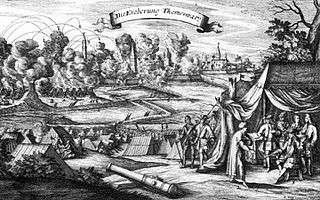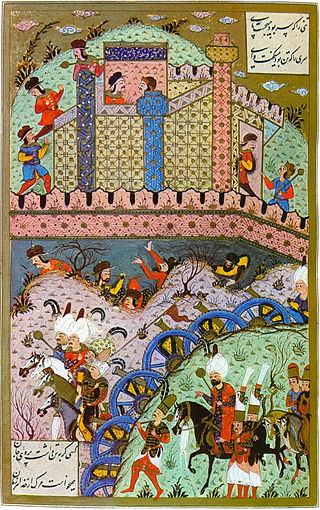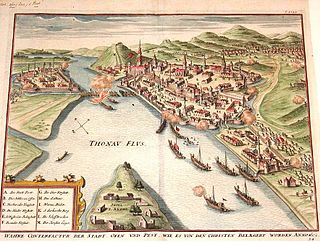
The Battle of Mohács was fought on 29 August 1526 near Mohács, Kingdom of Hungary, between the forces of the Kingdom of Hungary and its allies, led by Louis II, and those of the Ottoman Empire, led by Suleiman the Magnificent. The Ottoman victory led to the partition of Hungary for several centuries between the Ottoman Empire, the Habsburg monarchy, and the Principality of Transylvania. Further, the death of Louis II as he fled the battle marked the end of the Jagiellonian dynasty in Hungary and Bohemia, whose dynastic claims passed to the House of Habsburg.

The siege of Vienna, in 1529, was the first attempt by the Ottoman Empire to capture the capital city of Vienna, Austria, Holy Roman Empire. Suleiman the Magnificent, sultan of the Ottomans, attacked the city with over 100,000 men, while the defenders, led by Niklas Graf Salm, numbered no more than 21,000. Nevertheless, Vienna was able to survive the siege, which ultimately lasted just over two weeks, from 27 September to 15 October, 1529.

The Austro-Turkish War (1716–1718) was fought between Habsburg monarchy and the Ottoman Empire. The 1699 Treaty of Karlowitz was not an acceptable permanent agreement for the Ottoman Empire. Twelve years after Karlowitz, it began the long-term prospect of taking revenge for its defeat at the Battle of Vienna in 1683. First, the army of Turkish Grand Vizier Baltacı Mehmet defeated Peter the Great's Russian Army in the Russo-Turkish War (1710–1711). Then, during the Ottoman–Venetian War (1714–1718), Ottoman Grand Vizier Damat Ali reconquered the Morea from the Venetians. As the guarantor of the Treaty of Karlowitz, the Austrians threatened the Ottoman Empire, which caused it to declare war in April 1716.
The third and largest Battle of Szikszó was fought in October 1588 between the Kingdom of Hungary and the Ottoman Empire as part of the Ottoman–Hungarian wars. The Hungarian forces were fewer in number, but were victorious over the Ottomans. This unexpected victory was even mentioned by Emperor Rudolf decades after the battle. It was one of the most important Hungarian victories in the post-Mohács period.

The siege of Buda (1686) was fought between the Holy League and the Ottoman Empire, as part of the follow-up campaign in Hungary after the Battle of Vienna. The Holy League retook Buda after 78 days, ending almost 150 years of Ottoman rule.

The Habsburg monarchy and the Ottoman Empire waged a series of wars on the territory of the Kingdom of Hungary and several adjacent lands in Southeastern Europe from 1526 to 1568. The Habsburgs and the Ottomans engaged in a series of military campaigns against one another in Hungary between 1526 and 1568. While overall the Ottomans had the upper hand, the war failed to produce any decisive result. The Ottoman army remained very powerful in the open field but it often lost a significant amount of time besieging the many fortresses of the Hungarian frontier and its communication lines were now dangerously overstretched. At the end of the conflict, Hungary had been split into several different zones of control, between the Ottomans, Habsburgs, and Transylvania, an Ottoman vassal state. The simultaneous war of succession between Habsburg-controlled western "Royal Hungary" and the Zápolya-ruled pro-Ottoman "Eastern Hungarian Kingdom" is known as the Little War in Hungary.

The Hungarian–Ottoman wars were a series of battles between the Ottoman Empire and the medieval Kingdom of Hungary. Following the Byzantine Civil War, the Ottoman capture of Gallipoli, and the decisive Battle of Kosovo, the Ottoman Empire was poised to conquer the entirety of the Balkans. It also sought and expressed desire to expand further north into Central Europe, beginning with the Hungarian lands.

The siege of Buda ended with the capture of the city of Buda, the historical capital of the Kingdom of Hungary, by the Ottoman Empire, leading to about 150 years of Ottoman rule in parts of Hungary. The siege, part of the Little War in Hungary, was one of the most important Ottoman victories over the Habsburg monarchy during Ottoman–Habsburg wars in Hungary and the Balkans.

The siege of Gvozdansko was an Ottoman siege of the fort of Gvozdansko in the Kingdom of Croatia in 1577–1578. In the 1570s, the Ottomans intensified their efforts to capture the valley of the Una River. A string of forts along the Una, centred around Gvozdansko and in possession of the Zrinski noble family, formed the main line of defense of Croatia since 1527. The fort held off Ottoman attacks in 1540 and 1561.

During the siege of Naģykanizsa in 1601, a small Ottoman force held the fortress of Naģykanizsa in western Hungary against a much larger coalition army of the Habsburg monarchy, while inflicting heavy losses on its besiegers.

The siege of Buda was a siege by the Holy Roman Empire of the Ottoman fortress of Buda. After 109 days, the siege was abandoned.

The First battle of Komárom was one of the most important battles of the Hungarian War of Independence, fought on 26 April 1849, between the Hungarian and the Austrian Imperial main armies, which some consider ended as a Hungarian victory, while others say that actually it was undecided. This battle was part of the Hungarian Spring Campaign. After the revolutionary army attacked and broke the Austrian siege of the fortress, the Imperials, having received reinforcements which made them numerically very superior to their enemies, successfully counterattacked, but after stabilising their situation, they retreated towards Győr, leaving the trenches and much of their siege artillery in Hungarian hands. By this battle the Hungarian revolutionary army relieved the fortress of Komárom from a very long imperial siege, and forced the enemy to retreat to the westernmost margin of the Kingdom of Hungary. After this battle, following a long debate among the Hungarian military and political leaders about whether to continue their advance towards Vienna, the Habsburg capital, or towards the Hungarian capital, Buda, whose fortress was still held by the Austrians, the second option was chosen.

The siege of Temeşvar took place from 31 August to 12 October 1716 during the Austro-Turkish War of 1716-1718. The Habsburg army led by Prince Eugene of Savoy, who had just won a crushing victory at Petrovaradin, managed to capture the fortress of Temeşvar an Ottoman stronghold since 1552, the capital of the Banat and the last Turkish stronghold in Hungary. The garrison capitulated after a 43 days siege. The city remained under military administration until 6 June 1778, when it was handed over to the administration of the Kingdom of Hungary.

The siege of Székesfehérvár started in the month of August in 1543 when the Ottomans laid siege to the fortress.

The Ottoman-Habsburg War of 1551–1562 was a conflict between the Ottoman Empire and the Habsburg Monarchy supported by Royal Hungary. During the war, the Turks captured many castles in Hungarian and Transylvanian territory. The war ended in victory for the Ottoman Empire after the signing of the Treaty of Constantinople in 1562.

The Ottoman-Habsburg War (1565-1568) was a conflict between the Habsburg Empire and the Ottoman Empire fought mainly on the territory of Hungary and Croatia. During the war, the Turks captured the castle at Szigetvár but the death of Sultan Suleiman I forced them to retreat. The war ended in 1568 after the signing of a peace treaty in Edirne, under which both sides retained their territorial gains, and the Habsburgs further pledged to pay tribute of 30,000 forints to the Turks.

The Ottoman-Habsburg War (1529–1533), the first of a long series of wars between the Habsburg and Ottoman Empire.

The siege of Buda took place in 1602 during the Long Turkish War and was the second of three attempts to capture the town by the Habsburgs; however, it ended in failure, despite the Habsburg capture of Pest.

The siege of Buda took place in 1603 during the Long Turkish War and was the third and last attempt to capture the town by the Habsburgs; however, despite initial success achieved by the Habsburgs, the Ottomans later thwarted the Habsburg attempt to capture the town.

The siege of Esztergom in 1605 was a military engagement between the Habsburg garrison of Esztergom and the Ottoman army led by the grand vizier Lala Mehmed Pasha. The town was captured by the Ottomans.


















